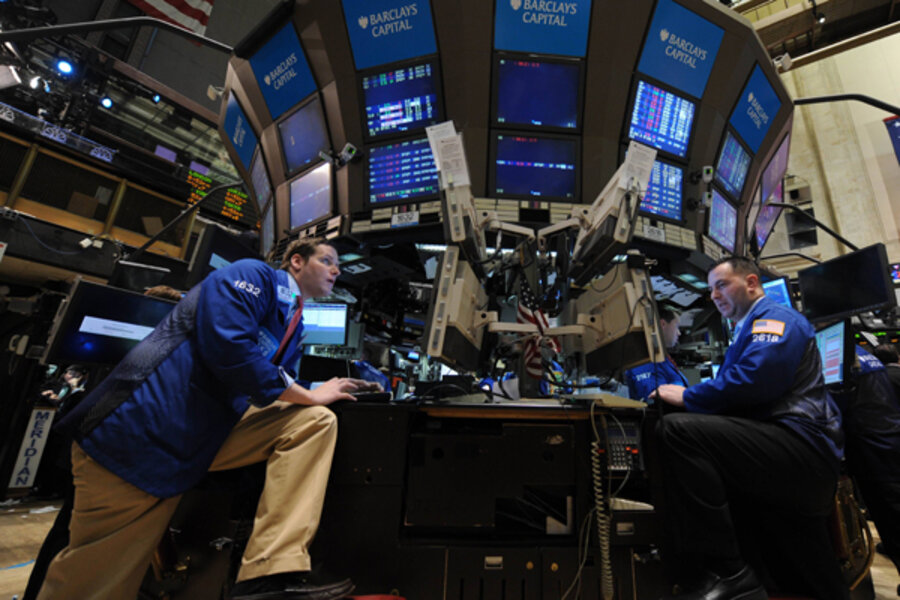SEC unveils 'flash crash' fixes, but Dow plunge still mysterious
Loading...
Regulators have issued a long report (PDF) on the May 6 "flash crash" in stocks, but much of it boils down to this: We still don't know what happened.
The two agencies that oversee key US financial exchanges said several steps are being pursued or considered to reduce the risk of such crashes, including new "circuit breakers" when individual stocks become unusually volatile.
But the Securities and Exchange Commission (SEC) and Commodity Futures Trading Commission (CFTC) said the review of the May 6 stock plunge "is in its preliminary stages" and that key questions remain unanswered.
The report reaches no conclusion, for example, on why shares in one of the sturdiest of blue-chip stocks – Procter & Gamble – took an even steeper dive than the rest of the Dow Jones Industrial Average on that Thursday.
More broadly, the Dow's nearly 1,000-point dive on that day also remains a large mystery.
"Beginning shortly after 2:30 p.m., [the day's] overall decline in the financial markets suddenly accelerated," the SEC and CFTC said in the report, issued late Tuesday. "Within a matter of a few minutes, there was an additional decline of more than five percent in both the equity and futures markets. This rapid decline was followed by a similarly rapid recovery."
Procter & Gamble (with the ticker symbol PG) fared much worse than the roughly 9 percent plunge the Dow saw from its open on May 6. "PG declined from more than $60 to a low of $39.37 in approximately 3.5 minutes," the report said. Then the stock recovered above $60 in about one minute.
Regulators and exchange officials have already reported to Congress about some of the May 6 details, including that a single firm was a large seller of so-called E-mini futures contracts on the Standard & Poor's 500 stock index during the pivotal time period. The new report gives the public additional details.
The regulators listed various factors that, in an interconnected way, may have helped cause the crash:
Links between different securities. Sharp declines in stock index products (such as exchange-traded funds and the E-mini S&P contract) may have influenced simultaneous or subsequent waves of selling in individual securities.
Market fragmentation. Markets such as the New York Stock Exchange, the NASDAQ, and over-the-counter markets are entwined but not well integrated, with similar securities trading on different platforms that have different rules. In some cases, trading was slowed in one venue, while continuing as normal in another.
Evaporation of liquidity. The role of "market maker" financial firms is under review, since they normally keep markets flowing by standing ready to buy or sell when others are doing the opposite. An apparent sudden decline in liquidity may have been deepened "by the withdrawal [of] electronic market makers."
Cascading trades. The crash may have been worsened by automated "stop-loss market orders," in which investors hope to protect themselves by getting out of a security that's falling fast. These and other types of trade orders "might have contributed to market instability," the report said.
The ETF connection. The investigation found that most exchange-traded fund (ETF) declines happened after broader markets had dropped. But ETFs ended up accounting for about 70 percent of the trades that were canceled after the fact by exchanges, because of the severe price swings. The regulators are looking into possible reasons ETFs were so affected, including whether some firms sold ETFs as a way to quickly reduce exposure to the market.
If all these are parts of the puzzle, they still need to be pieced together to explain how some stocks dropped to one penny per share before rebounding. In all, roughly 14 percent of securities suffered greater declines than the broader market on May 6.
"The whipsawing prices resulted in investors selling at losses during the decline and undermined confidence in the markets," the report said.
That explains why, even as the investigation continues, regulators are working on new safety measures:
• Exchanges are expected to implement circuit breakers for individual stocks. A pause in trading would allow market makers to mobilize to meet sudden surges in demand for liquidity.
• Regulators say the exchanges should improve their procedures for breaking (canceling) trades that occur at off-market prices. The policies should become more consistent, transparent, and predictable, they say. On May 6, the cut-off point for many broken trades was that the security had swung 60 percent or more in price. That's cold comfort to someone who lost, say, 50 percent on a trade.
• The regulators also say they are "reviewing the obligations of professional liquidity providers and evaluating the use of various order types (market orders, stop loss orders)."
Related:





